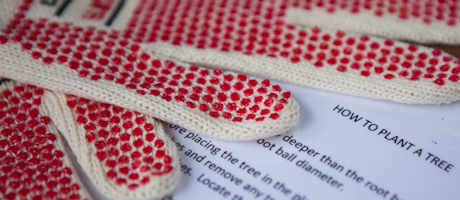As the George Washington University celebrated Earth Day, President Steven Knapp announced a new $2 million revolving fund for sustainability that will initially improve buildings on campus, making them more energy efficient.
The idea behind the Green Campus Fund is that it will be self-sustainable. The university will use the fund to improve a building’s efficiency, and then in turn will take the cost savings from those improvements and put it back into the fund.
The fund will provide seed funding to implement the university’s Climate Action Plan—an outline for how the university can achieve carbon neutrality. During the first year, the fund will prioritize energy saving projects on the Foggy Bottom campus. The Climate Action Plan, which will be released on May 15, was created by a team of internal and external experts, students, staff and faculty. In the future, the intent is to use the Green Campus Fund to support GW’s sustainability priorities for water conservation and improving our ecosystems.
"Each year, Earth Day gives us an opportunity to strengthen our commitment to sustainability, and this year we are doing so with several important new initiatives," President Knapp said. "I am grateful to our faculty, students, and staff for the impressive energy and creativity they invest in our efforts to become a model of urban sustainability."
In addition to the fund, GW announced it is exploring a plan to provide solar heated water in several residence halls.
“Given the George Washington University’s urban location at the heart of the nation’s capital, we have a particular opportunity and responsibility to help green our cities so that our natural systems will be healthy and thriving,” said Meghan Chapple-Brown, director of GW’s Office of Sustainability. “The investments we are announcing today will not only reduce our carbon footprint but will also help us make our operations more efficient and save money in the long-run by cutting our energy use.”
The idea for the Green Campus Fund came from a coalition of student groups. Four GW students—Andy Ludwig, Krishna Gulkotwar, Jordan Phillips and Kristina Van Dexter—worked with the Office of Sustainability to provide additional background research.
Mr. Phillips, who started the Revolution Green living and learning cohort, recognized that funding would be a major obstacle for modernizing GW’s buildings.
“GW had no permanent fund for green projects, but all the while many of these projects we wanted to implement could save money on water and electricity usage,” said Mr. Phillips. “The Green Campus Fund will allow GW to further its sustainable goals while at the same time relieving some financial pressure to do so. But more importantly it establishes a long term commitment to sustainability that should grow as the university grows.
GW has already made substantial efforts to make its campuses more sustainable.
In 2007, GW committed to make new construction Leadership in Energy and Environmental Design (LEED) certified. Earlier this month, South Hall, GW’s newest residence hall, became the first university building in the District to receive LEED Gold Certification. GW’s second building built to LEED standards, Pelham Hall on GW’s Mount Vernon Campus, will open this summer.
In addition to making improvements inside buildings, GW has committed to making green spaces.
On Thursday, President Knapp unveiled a new green plaza located near South Hall. The space contains native and adapted planting that require minimal watering and a stormwater reclamation system. By collecting rainwater and using it for watering trees and flowers on campus, the system will reduce urban run-off. The green plaza will be an open space featuring more than 20 trees, an activity lawn, trellised seating and landscaped areas.
Earlier this week, GW launched the Institute for Sustainability Research, Education and Policy, which will focus on four key areas of sustainability: global climate change, sustainable organizations, sustainable communities and infrastructure and urban sustainability.
Led by Mark Starik, department chair and professor of strategic management and public policy in the School of Business, the institute will promote, initiate and evaluate GW sustainability research. The institute will also analyze and disseminate information about sustainability-related policies to government, businesses and nonprofit organizations.
The university’s Office of Research has also established a sustainability research task force, which has been charged with providing recommendation on possible research endeavors.
GW already offers more than 130 courses and 10 certificates and degrees related to sustainability, ranging from an undergraduate environmental studies major to a new graduate program in sustainable urban planning. There are more than 70 faculty members, who teach a sustainability-related course or are conducting sustainability research.
“Through our sustainability commitments, we are taking responsibility for ensuring a better quality of life for today and tomorrow,” said Ms. Chapple-Brown. “While the journey is not easy, direct or simple, it is a journey worth taking for the sake of future generations.”
Comments? Criticism? The conversation continues. We welcome reactions, commentary and story recommendations on our Facebook page.


